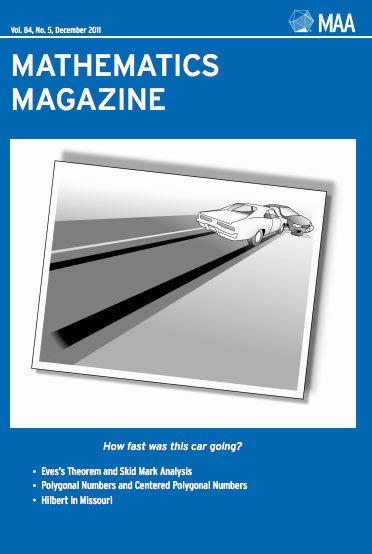- About MAA
- Membership
- MAA Publications
- Periodicals
- Blogs
- MAA Book Series
- MAA Press (an imprint of the AMS)
- MAA Notes
- MAA Reviews
- Mathematical Communication
- Information for Libraries
- Author Resources
- Advertise with MAA
- Meetings
- Competitions
- Programs
- Communities
- MAA Sections
- SIGMAA
- MAA Connect
- Students
- MAA Awards
- Awards Booklets
- Writing Awards
- Teaching Awards
- Service Awards
- Research Awards
- Lecture Awards
- Putnam Competition Individual and Team Winners
- D. E. Shaw Group AMC 8 Awards & Certificates
- Maryam Mirzakhani AMC 10 A Awards & Certificates
- Two Sigma AMC 10 B Awards & Certificates
- Jane Street AMC 12 A Awards & Certificates
- Akamai AMC 12 B Awards & Certificates
- High School Teachers
- News
You are here
Mathematics Magazine - December 2011
In this issue we see powerful techniques illustrated through applications. Marc Frantz uses Eves’s Theorem to analyze skid marks, Steven Schlicker applies Pell’s Equation to polygonal numbers, and inclusion-exclusion, dilogarithm functions, and numerical differentiation all make appearances. We also have David Zitarelli’s history of the University of Missouri mathematics department. What was Hilbert doing there?—Walter Stromquist, Editor
ARTICLES
A Car Crash Solved—with a Swiss Army Knife
Marc Frantz
Though not well known, Eves’s theorem is a fundamental result of projective geometry—a tool as versatile as a Swiss Army knife. Named for the late Howard W. Eves (1911–2004), the theorem establishes a class of numerical projective invariants, of which the famous cross ratio is a special case. We illustrate the versatility of Eves’s theorem by applying it to accident scene reconstruction, to the circular products in the theorems of Ceva and Menelaus, and to perspective illustrations of the geometric mean. In addition, we show that the theorem is illustrated by everyday photographs of buildings and other common objects.
Read the full article (pdf).
Numbers Simultaneously Polygonal and Centered Polygonal
Steven J. Schlicker
The study of polygonal numbers (triangular, square, etc.) has a long and rich history. Similar, but lesser known, are the centered polygonal numbers which have not been as extensively studied. These sequences of figurate numbers contain a wealth of interesting and fun mathematics. As an example, we make connections between the polygonal and centered polygonal numbers to find a previously unknown family of integer sequences that describe those numbers that are simultaneously polygonal and centered polygonal for the same number of sides.
Hilbert in Missouri
David Zitarelli
David Hilbert never traveled to the United States yet he exerted considerable influence on the development of mathematics in the country during the first half of the twentieth century through the thirteen Ph.D. students he produced from 1899 through 1910. This article introduces three of those graduates (Earle Hedrick, O. D. Kellogg, and W. D. A. Westfall) who formed the nucleus of the vibrant mathematics department at the University of Missouri 1903–1925 and who played important roles in the expansion of mathematical activities into what was then the southwestern part of the U.S. The impressive curriculum this trio constructed without aid of a Ph.D. program produced several notable mathematicians. Moreover, the careers of some of their colleagues illustrate various aspects of academic life in America a century ago.
NOTES
An Upper Bound for the Expected Difference between Order Statistics
Manuel Lopez and James Marengo
It is well known that the order statistics of a random sample from the uniform distribution on the interval [0, 1] have Beta distributions. In this paper we consider the order statistics of a random sample of n data points chosen from an arbitrary probability distribution on the interval [0, 1]. For integers k and l with 1 ≤k ≤ l ≤ n we find an attainable upper bound for the expected difference between the order statistics Yl and Yk. This upper bound depends on the choice of k and l but does not depend on the distribution from which the data are obtained. We suggest a possible application of this result and we discuss some of its special cases.
Counting Irreducible Polynomials over Finite Fields Using the Inclusion-Exclusion Principle
Sunil K. Chebolu and Ján Miná?
C. F. Gauss discovered a beautiful formula for the number of irreducible polynomials of a given degree over a finite field. Using just very basic knowledge of finite fields and the inclusion-exclusion formula, we show how one can see the shape of this formula and its proof almost instantly.
Series Involving Products of Two Harmonic Numbers
Ovidiu Furdui
The paper is about the calculation of the nonlinear harmonic series ![]() , where k is a nonnegative integer and Hndenotes the nth harmonic number. We show that, when k ≥ 1, the sum Skcan be written as a rational linear combination of ζ(2), ζ(3) and the first k harmonic numbers.
, where k is a nonnegative integer and Hndenotes the nth harmonic number. We show that, when k ≥ 1, the sum Skcan be written as a rational linear combination of ζ(2), ζ(3) and the first k harmonic numbers.
“Even with THAT Step Size?”
Joe Latulippe and Jennifer Switkes
The centered difference quotient is the simplest centered approximation for the derivative of a function at a point. In this paper, we explore and apply general centered approximation formulae for the derivative of a function at a point using any number of weighted evenly-spaced nodes. The resulting formulae have connections to both Vandermonde matrices and Lagrange polynomials and lead to interesting combinatorial identities.





